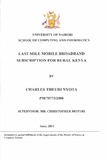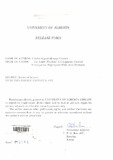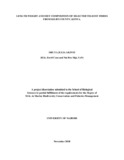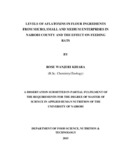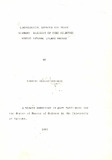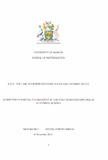Browsing Faculty of Science & Technology (FST) by Title
Now showing items 2385-2404 of 4025
-
Laser Raman Spectroscopic Assessment of Honey Adulteration by Molasses
(University of Nairobi, 2022)Honey adulteration by cheaper sweeteners such as sugar syrups, synthetic honey, molasses, and sugar beet has become a common vice thus negatively affecting the quality of honey production, and diminishing its market value. ... -
Last mile mobile broadband subscription for rural Kenya
(University of NairobiSchool of Computing and Informatics, 2011)The government of Kenya in its effort to revamp its telecommunication sector, which is hitherto hampered by inadequate international connectivity, has been facilitating the establishment of submarine cables. Despite these ... -
Layered information security framework
(School of computing and Informatics, 2005)This project has developed a framework which is layered. The framework can be used by any organization to rate their security "goodness" by being able to know what they have been able to implement and what is lacking. ... -
The Leakey Window:A Congestion Control Technique for High-Speed Wide Area Networks
(University of NairobiCollege of Biological and Physical Sciences, 1992)Congestion control in high-speed wide area networks (HS- WAN s) is a very important issue since the presence of congestion may have catastrophic re- sults. Reactive mechanisms applied to existing slow speed networks are ... -
Learning support system using agents in E-learning
(School of computing and Informatics, 2012)E-learning opportunities for students have become increasingly popular with more and more institutions of higher learning finding the need to start online programs. Much of this increase is attributed to the demands of ... -
Learning to use sas to analyze biomedical data using data collected for: urban-rural differences in lung function in Kenyan school children
(School of Mathematics, University of Nairobi, 2003)The overall goal of this thesis was to learn how to analyze biomedical data using SAS, a software system for data analysis. In order to achieve this I joined a SAS training seminar held on July 18-22, 2003, at the Centres ... -
Lectin expression associated with plasmodium infections in anopheles
(Department of Zoology, University of Nairobi, 2003)The variation of the mannose-binding protein (MBP) gene and the role of lectins during infection in mosquitoes were investigated using genomic DNA approach based on sequencing of the gene and the levels of its expression ... -
Length-Weight And Diet Composition Of Selected Teleost Fishes From Kilifi County, Kenya
(University of Nairobi, 2018)Sustainable exploitation of fishery resources requires knowledge of the population dynamics of the target resource. Studies have shown consistence and considerable decline in the densities and species richness of most coral ... -
Lethal and sub-lethal effects of DDT, carbofuran, trifenmorph and niclosamide on oreochromis niger gunther (1898)
(University of NairobiFaculty of Science, 1989)Oreochromis niger fry were exposed to various concentrations of DOT, Carbofuran, Trifenmorph and Niclosamide to determine the toxicity of these chemicals to the fish. The concentration lethal to 50% of the fish population ... -
Levels of aflatoxins in flour ingredients from micro, small and medium enterprises in Nairobi County and the effect on feeding rats
(University of Nairobi, 2015)In Kenya, aflatoxicosis is a major public health concern and several outbreaks have occurred in the past due to the consumption of contaminated maize and maize products. Even when there are no reported cases of illness or ... -
Leveraging Biometrics for Access Control Management in Learning Institutions
(University of Nairobi, 2019)A common problem plaguing institutions of higher learning is how to monitor and manage student and staff attendance and access to key location, especially in institutions with multiple locations and the high population. ... -
Leveraging robotic process Automation as an enabler of organizational Digital Transformation: a case of a Telecommunication Company in Kenya
(University of Nairobi, 2020)Organizations are adopting newer technologies in a rapidly evolving digital environment to develop new or change present business processes to meet changing business and customer expectations. Robotic Process Automation ... -
Limnological aspects and trace element analysis of some selected Kenyan natural inland waters
(Facult of Science, University of Nairobi, 1987) -
The limnology and management of thika dam Ndakaini, Kenya
(Department of zoology, 2002)The sources of water for cities include Rivers and streams, lakes and reservoirs. The capacities of these sources to meet these demands are however challenged by sedimentation and enrichment of lakes and reservoirs by ... -
Lindley distribution and its generalization in poisson mixtures
(University of Nairobi, 2020)There are many distributions for modeling lifetime data, among the known parametric models, the most popular is Gamma, Beta, Poisson and Lindley. Lindley distribution is a way to describe the lifetime of a process. The ... -
Lines on Cubic Surface Research Report in Mathematics, Number 04, 2021
(University of Nairobi, 2021)In this dissertation, we enumerate the 27 lines on a smooth cubic surface X ⊂ P3. We do this by understanding the combinatorics of the subset S of disjoint lines on X of the Grassmanian Gr(2,4) of lines on P3. Further, ... -
The link between rates and interest rates
(School of mathematics, 2012-11)In recent years, there has been a special interest in the link between exchange rates and interest rates in both advanced and developing countries. This is understandable, given the important role these variables play ... -
Litho-seismo Stratigraphy and Basin Analysis of the Sirius 1 Prospect, Chalbi Sub Basin, Northern Kenya
(University of Nairobi, 2018)In recent years, global exploration for hydrocarbon accumulations in commercial quantities has become increasingly difficult, and as a result, exploration projects have extended into more geologically challenging areas. ... -
Lithostratigraphic analysis and palaeoenvironmental Interpretation of the late tertiary and quaternary sediments of The Nakuru, Elmentaita and Naivasha basins.
(Department of Geology, University of Nairobi, 1993)The objective of this thesis is to provide a better understanding and correlation of the lacustrine palaeoenvironments of the late Tertiary and Quaternary rift sediments within the basins of Lakes Nakuru, Elmentaita ...


